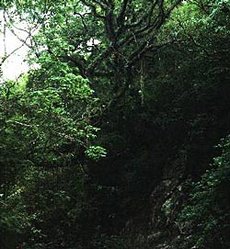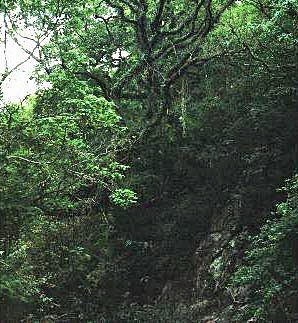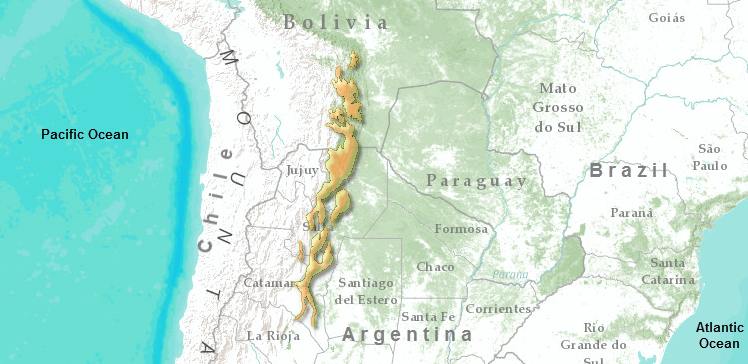Southern Andean Yungas
This ecoregion is extremely fascinating from a biogeographic perspective, as it contains what may be the last of the isolated ‘evergreen’ forests resulting from Quaternary glaciations. This region is rich in fauna species, especially avifauna. Many tropical species meet their southern limits of geographic distribution in this region. The forests of Argentina have suffered more damage than Bolivia. A number of national parks protect the forest of this ecoregion.
Location and General Description
The Southern Andean Yungas are loosely bordered to the east by the Chaco, and tightly interdigitated to the west with Bolivian Montane Dry Forest, spanning southwestern Bolivia and northwestern Argentina. The northern, southern, western and eastern boundaries of this ecoregion terminate at approximately the 170 and 280 south latitudes and 670 and 630 west longitudes, respectively. The wet and humid climate is deposited by northern trade winds, and rains typically exceed 2,500 millimeters (mm) per year. The altitude generally ranges from 800 – 2,500 meters (m), but may reach heights exceeding 3000 m.
This ecoregion essentially forms a mesic habitat that lies between two much drier habitats: the Chaco to the east, and the higher Puna to the west. The habitat is evergreen forest, with canopy height typically not exceeding 15 m. Between 1,200 – 2,500 m the forest is dominated by Andean Alder (Alnus acuminata) and Mountain Pine (Podocarpus parlatorei) or Queñoa (P. australis); at lower elevations these species form a mosaic with other trees, especially Lauraceae and Myrtaceae.
Biodiversity Features
 El Cantadero, Argentina. (Photograph by WWF/Manuel Nores)
El Cantadero, Argentina. (Photograph by WWF/Manuel Nores) Like the Bolivian Yungas (Ecoregion) to the north, this region is also quite strong in endemics, including approximately 10 avian species that are range-restricted, including species such as the Red-faced Guan (Penelope dabbenei), Rothschild’s Swift (Cypseloides rothschildi) and the Rufous- throated Dipper (Cinclus schulzi).
Many strongly tropical species meet their southern limits of geographic distribution in this region. In light of the strong affinities of this region to typical lowland evergreen forest, the high diversity of wide-ranging, lowland Neotropical mammals of large size is quite likely. Examples include a variety of herbivores such as White-lipped and Collared Peccary (Tayassu) and Lowland Tapir (Tapirus terrestris), as well as cats such as Jaguar (Panthera onca), Puma (Puma concolor), Margay (Felis wiedii) and Jaguarundi (Herpailurus yagouaroundi).
Current Status
The extent of deforestation in Bolivia has not been documented with certainty, but there are large areas of degraded land. However, some large and intact regions still persist in Bolivia, such as the forests between the Pilcomayo and Pilaya rivers in Montes Chapeados that span ~1300 km2. The situation in Argentina is apparently grave as more than one-half of the original forest has disappeared, due to logging, agriculture, exotic Pinus invasion, road development, human colonization and unsustainable tourism.
There are a number of National Parks (NPs) and protected areas in this ecoregion, in both Bolivia (Tariquía National Reserve – 2469 km2) and Argentina (Calilegua NP - 760 km2, Baritú NP - 724 km2, El Rey NP - 442 km2, Potrero de Yala Provincial Park - 43 km2).
Types and Severity of Threats
Unfortunately, most of these parks are of smaller size in light of how threatened the region is overall. This is especially the case in Argentina, where the total km2 of the combined four Argentinean parks (1969 km2) does not even rival the single Bolivian park in this ecoregion. However, a proposal under consideration by the government of Tucumán, Argentina would create the Campo de los Alisos NP (2500 km2), thereby more than doubling the km2 of protected area in this threatened ecoregion.
Justification of Ecoregion Delineation
The delineation for these southern yungas were to represent the distinct montane transitional forests of the southern Andes from high puna habitats to the lowland forests below. These rugged mountains and foothills host many endemic species and astounding beta-diversity on both an elevational and latitudinal gradient. The linework for the Bolivian portion follows the Ribera et al classification of "subandean montane forest" and "subandean submontane forest", both of the Tucuman-Bolivian geologic formation. The Argentine portion follows a number of sources, including Morello and Cabrera, but final linework follows the natural regions map of Daniele and Natenzon who classify this as "forest of the yungas".
Additional Information on this Ecoregion
- For a shorter summary of this entry, see the WWF WildWorld profile of this ecoregion.
- To see the species that live in this ecoregion, including images and threat levels, see the WWF Wildfinder description of this ecoregion.
- World Wildlife Fund Homepage
Further Reading
- Anon. 1980. Time-Hammond World Atlas. Hammond, Inc., U.S.
- Brooks, D.M. 1991. Preliminary comparisons of large mammal guilds in five semi-arid environments of the New World. Proc. IX Mtg. Tx. Soc. Mamm., Junction, Texas.
- Cabrera, A. L. 1976. Regiones fitogeográficas Argentinas. Enciclopedia Argentina de Agricultura y Jardinería, Second Edition, Vol. II, Buenos Aires, Argentina.
- Chalukian, S. n.d. Evaluación preliminar de la distribución, status y habitat del tapir (Tapirus terrestris) en la region de las Yungas, noroeste de Argentina.
- Daniele, C., and C. Natenzon. 1994. Regiones Naturales de la Argentina. Draft map. Argentina National Parks Department, Buenos Aires, Argentina.
- Halloy, S., J.A. González and A. Grau. 1994. Proyecto de creación del Parque Nacional Aconquija (Tucumán, Argentina): Rpt. No. 4. Fund. Miguel Lillo, Nat. Cons. Ser. 9, Tucumán.
- Fjeldså, J. and S. Mayer. 1996. Recent ornithological surveys in the Valles region, southern Bolivia and the possible role of Valles for the evolution of the Andean avifauna. Cntr. Rsrch. Cult. Biol. Divers. Andean Rainforests, Danish Envion. Rsrch. Prog.
- Morello, J. 1968. La vegetación de la República Argentina, No. 10: Las grandes unidades de vegetación y ambiente del Chaco Argentino. Buenos Aires, Argentina.
- Nores, M. 1992. Bird speciation in subtropical South America in relation to forest expansion and retraction. Auk 109: 346-357.
- Ojeda, R.A. and M.A. Mares, 1989. A Biogeographic Analysis of the Mammals of Salta Province, Argentina: Patterns of Species Assemblages in the Neotropics. Spec. Publ., Mus. Texas Tech Univ. 27. ISBN: 0896721728
- Olson, D., E. Dinerstein, P. Hedao, S. Walters, P. Allnutt, C. Loucks, Y. Kura, K. Kassem, A. Webster and M. Bookbinder. 2000. Terrestrial Ecoregions of the Neotropical Realm (map). Conserv. Sci. Program, WWF-US, DC.
- Ribera, M.O., M. Libermann, S. Beck, and M. Moraes. 1994. Mapa de la vegetacion y areas protegidea de Bolivia. 1:1,500,000. Centro de Investigaciones y Manejo de Recursos Naturales (CIMAR) and Universidad Autónoma Gabriel Rene Moreno (UAGRM), La Paz, Bolivia.
- Stattersfield, A.J., M.J. Crosby, A.J. Long and D.C. Wege. 1998. Endemic Bird Areas of the World: Priorities for Biodiversity Conservation. Birdl. Cons. Ser. 7, Cambridge, UK.
- Tarifa, T., 1996. Mamíferos. Pp. 165-264. En: P. Ergueta y C. de Morales, editors, Libro Rojo de los Vertebrados de Bolivia CDC-Bolivia.
- Vervoorst, F. 1979. La vegetación del noroeste argentino y su degradación. Ser. Cons. Natu. Fund. Miguel Lillo 1: 5-9.
- WWF/IUCN. 1997. Centres of plant diversity: A guide and strategy for their conservation, 3: North America, Middle America, South America, Caribbean Islands. WWF and IUCN, Cambridge, UK.
| Disclaimer: This article is taken wholly from, or contains information that was originally published by, the World Wildlife Fund. Topic editors and authors for the Encyclopedia of Earth may have edited its content or added new information. The use of information from the World Wildlife Fund should not be construed as support for or endorsement by that organization for any new information added by EoE personnel, or for any editing of the original content. |

